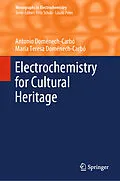This monograph overviews the importance of electrochemistry in the field of cultural heritage, including archaeology, conservation and restoration topics. The application of electrochemical techniques in these domains have experienced a notable growth during the last ten years, in particular with regards to the elucidation of composition, manufacturing techniques and chronology of archaeological artefacts. This book describes the application of solid state electrochemistry techniques for the use of samples at the nanogram level from paintings, metallic, ceramic, glass, glazed, wooden, and other objects, and it also includes the description of new dating procedures for archaeological objects made of these materials. It is a valuable contribution to the field of cultural heritage and will be of great interest to archaeologists, conservators and restorers as well as to physicists and chemists working on the scientific examination of works of art.
Autorentext
Antonio Doménech-Carbó (València, Spain, 1953) is Professor at the Department of Analytical Chemistry, Universitat de València (PhD 1989). His research is focused on solid-state electrochemistry with particular emphasis on the study of porous materials and the development of electroanalytical methods for archaeometry, conservation, and restoration. He is the author of over 250 articles including one IUPAC technical report, and several books; among them, Electrochemical Methods in Archeometry, Conservation, and Restoration (Springer, 2009), Electrochemistry of immobilized particles and droplets (2nd ed. Springer, 2014), and Electrochemistry of Porous Materials (Taylor & Francis, 1st edit. 2010, 2nd edit. 2021). Currently, is a member of the editorial board of ChemTexts (Springer) and topical editor of the Journal of Solid State Electrochemistry (Springer). He is a reviewer of the European Research Council and several national research agencies and a referee of over 180 indexed journals.
